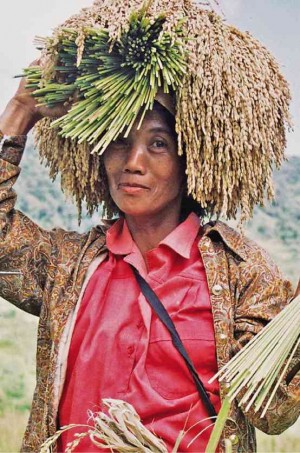Women’s unheralded role in rice farming

A WOMAN farmer harvests the native rice variety “kintoman” in the rice terraces of Maligcong in Bontoc town, Mountain Province. EV ESPIRITU
As a babysitter in Hong Kong, Margarita Allado was earning P9,000 monthly for two years. In 1992, she decided to come home in Ilocos Norte province to help her husband tend their 1.5-hectare rice farm in the village of Pias Norte in Currimao town.
She did not regret her decision. The success of the farming venture gave her time to raise their children well and provide for their education.
“There’s personal gratification, such as providing food for your family and selling the harvest, in helping your husband tend the farm. You feed your family and you earn by helping others put something in their stomach,” Allado said in a Philippine Rice Research Institute (PhilRice) documentation of women involved in farming.
Allado, who is chair of the barangay council of Pias Norte, is among the many women involved in rice farming in the country. Others tend their own farms or support their husbands in farm work.
Male domain
Article continues after this advertisementWomen’s roles in rice farming have not been talked about since the work has always been considered a male domain.
Article continues after this advertisementPhilRice, through its Rice Science Museum in the Science City of Muñoz in Nueva Ecija province, has given women the recognition they deserve by featuring them in a section of an exhibit, called “Bountiful Harvest,” which opened recently.
The exhibit is mounted with assistance from the PhilRice Foundation Inc.
Diadem Gonzales-Esmero, the museum curator, said women’s roles in agriculture had not often been recognized based on findings of several surveys. “Through this exhibit, we hope the public will appreciate more this unheralded women’s role [in rice farming],” she said.
Ten panels, quoting statistics based on a survey conducted by the Philippine Center for Rural Development Studies (Centro Saka Inc.), showcased in pictures the participation of women in different aspects of rice production.
“In planting, women outnumber the men, and months after, they lend helping hands in harvesting and drying the produce, logging 2.33 more days in harvesting and 2.75 more days in drying rice than the period men spend for them,” one panel caption read.
On top of keeping the home and ensuring that family members are nourished and children properly reared, women spend as long as 11 hours a day during planting and harvesting seasons, another panel said.
“The woman … does not count the hours or the wages of her work on the farm. But on top of them, whether life’s a breeze or a storm, the apt rearing of her children and keeping the home are her top priorities. Off farm, she prepares the tools for farm labor, does gardening, food foraging, wood gathering and raises poultry or livestock and even endures ‘paglalabada’ (laundry work) for additional income,” it said.
The wife leads in securing capital for farm operation, but the husband has the bigger decision in spending it.
“The husband depends on the wife on her sound decision on household matters, medication in times of illness, what food to prepare, appliances to buy, where to get money in times of emergencies and even on whom to vote during elections,”
another panel said.
Other sections in the museum display tools and other implements used in rice farming, which were lent by the agricultural museum of Central Luzon State University, and the technology used in achieving bountiful harvests.
“Our exhibit is meant to spread the history, culture, arts and sciences behind the Filipino staple,” Esmero said.
Ifugao rice culture
The Rice Science Museum first showcased rice science with the Ifugao rice culture as centerpiece when it opened in September.
Baguio City-based artist Roger Vibal, who was assisted by PhilRice in-house artist Carlito Vibal, helped Esmero in planning and setting up the exhibits.
Agriculture Undersecretary Segfredo Serrano, who was guest during the inauguration, said the project had put in right perspective the important roles of the rice sector in the economy and society.
“[We hope] that this museum can address the concerns in rice production and the industry without much of the sentimentality. Instead, [we focus on] realities and challenges faced by the sector, rice farmers and consumers and their place in society, culture and our common future,” Serrano said.